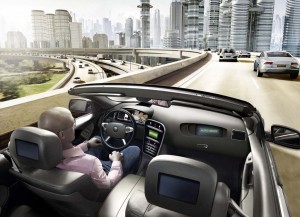Interest in the latest in advanced automotive technology is growing but consumers are put off by the high cost of many of the latest features, a new study indicates.
A solid majority of vehicle owners say they interested in technology related to fuel economy, device/application linking for smart phones, wireless connectivity, natural language voice activation and a variety of infotainment features in their next vehicle, according to the J.D. Power and Associates 2013 U.S. Automotive Emerging Technologies Study.
Of the 22 technology features included in the 2013 J.D. Power study, fuel economy indicator and active shutter grille vents –both energy-related technologies – showed the highest level of interest from vehicle owners.
Fuel economy indicator is second highest in pre-price feature interest, followed by active shutter grille vents. In recent years, automotive brands have rolled out fuel economy assisting technology, which has helped increase familiarity with the technology and its benefits. The active shutter grille vents feature is now available on select domestic vehicles.
“Vehicle owners are continually aware of rising fuel costs and the need for better fuel economy,” said Mike VanNieuwkuyk, Power’s executive director of global automotive. “As they have come to understand the benefits of new automotive technology, they are increasingly interested in those that allow them to manage their fuel consumption with greater efficiency and help better manage their cost at the pump.”
Consumer interest declines across all features when pricing becomes a factor. And the higher the cost, the lower the level of interest – with rare exception.
Fuel economy indicators and active shutter grille vents have among the lowest drop, decreasing 7 percentage points and 16 percentage points, respectively, compared with other technology features examined in the study. In part, fuel economy indicator and active shutter grille vents maintain vehicle owner interest because of their lower relative pricing at $50 and $150, respectively.
Energy technology mentions on social media have shown a notable increase within the past year, as consumers have placed a heightened emphasis on saving fuel. However, fuel economy-conscious vehicle owners seem to struggle with the unfamiliarity of stop/start technology and many social media mentions focus on how to turn this feature off altogether.
Pricing, on the other hand, has a large impact on interest in smartphone app and wireless connectivity-related systems. The number of consumers who want device application links drop from 82% to 67% once a $250 price tag is attached. For heads-up displays interest drops from 74% to 58% when the $300 price tag is attached.
More than 67% of vehicle owners have a smart phone, according to J.D. Power, and they expected the devices to integrate easily with the system in their personal vehicle. “They want to use their smartphone in-vehicle with the same ease and functionality they have become accustomed to in their personal or business life,” J.D. Power found.
However, a key challenge is that many owners keep their vehicles for more than five years, and software upgrades for device linking technology lags the introductions of new smartphones.
“Automakers have an important opportunity to gain a competitive advantage by working side-by-side with smartphone and application developers to provide a seamless smartphone experience for in-vehicle control of GPS/mapping, music, weather, search tools, travel and more,” said VanNieuwkuyk.
In the 2013 study, he noted, 82% of vehicle owners with smartphones expressed interest in an in-vehicle device/application link that would connect their smartphone to their vehicle’s infotainment system, compared with 78% in 2012.
Consumers believe that vehicle infotainment systems are inferior to their smartphones and tablets and want more mobile apps and control of software updates to integrate with their vehicle.
Gen-Y vehicle owners are more likely to be interested in device application linking technology at every price level, but the largest increase from the 2012 to the 2013 survey came among Early Boomers, those born between 1947 and 1953.
Fully autonomous driving is still a relatively new concept but interest is rising slightly to 21% in 2013 compared with just 20% in 2012. There is greater interest in semi-autonomous systems, such as emergency braking and steering. Automatic park assist systems – found on a number of 2013 models – was favored by 40% of those surveyed.
“Fully autonomous driving is slowly working its way into the mindset of vehicle owners by way of those who utilize semi-autonomous driving features with comfort and confidence,” said VanNieuwkuyk.
Men show high interest at market price for low-speed collision avoidance systems, emergency braking and steering and fully autonomous driving, at 58%, 42% and 23% respectively. Younger owners are more interested in emerging driving technologies, with Generation X having the highest market price interest in low-speed collision avoidance, at 59%. Generation Y showed the highest market price interest for emergency braking and steering, at 44%.
Interest in fully or semi-autonomous driving features primarily originates from wanting to have the latest technology, with the safety benefit being an added bonus.
The 2013 Power U.S. Automotive Emerging Technologies study is based on responses from 16,758 vehicle owners.


Is it any surprise why distracted driving accidents have also increased?